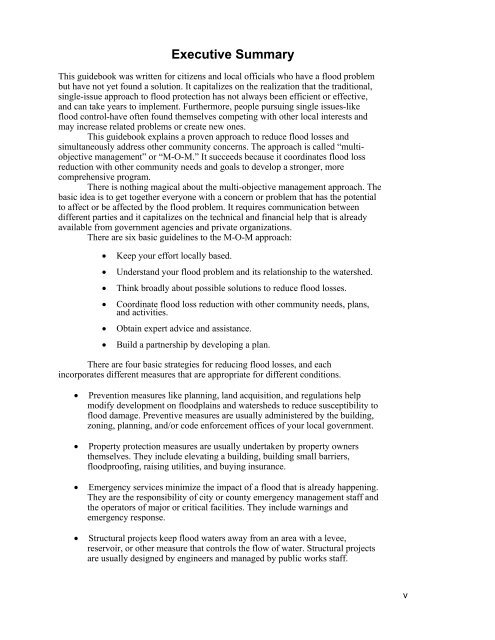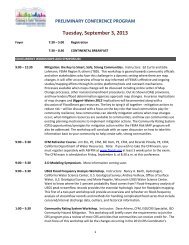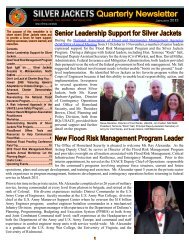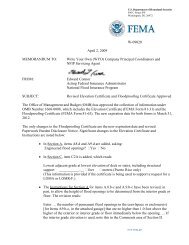Using Multi-Objective Management to Reduce Flood Losses in Your
Using Multi-Objective Management to Reduce Flood Losses in Your
Using Multi-Objective Management to Reduce Flood Losses in Your
Create successful ePaper yourself
Turn your PDF publications into a flip-book with our unique Google optimized e-Paper software.
Executive Summary<br />
This guidebook was written for citizens and local officials who have a flood problem<br />
but have not yet found a solution. It capitalizes on the realization that the traditional,<br />
s<strong>in</strong>gle-issue approach <strong>to</strong> flood protection has not always been efficient or effective,<br />
and can take years <strong>to</strong> implement. Furthermore, people pursu<strong>in</strong>g s<strong>in</strong>gle issues-like<br />
flood control-have often found themselves compet<strong>in</strong>g with other local <strong>in</strong>terests and<br />
may <strong>in</strong>crease related problems or create new ones.<br />
This guidebook expla<strong>in</strong>s a proven approach <strong>to</strong> reduce flood losses and<br />
simultaneously address other community concerns. The approach is called “multiobjective<br />
management” or “M-O-M.” It succeeds because it coord<strong>in</strong>ates flood loss<br />
reduction with other community needs and goals <strong>to</strong> develop a stronger, more<br />
comprehensive program.<br />
There is noth<strong>in</strong>g magical about the multi-objective management approach. The<br />
basic idea is <strong>to</strong> get <strong>to</strong>gether everyone with a concern or problem that has the potential<br />
<strong>to</strong> affect or be affected by the flood problem. It requires communication between<br />
different parties and it capitalizes on the technical and f<strong>in</strong>ancial help that is already<br />
available from government agencies and private organizations.<br />
There are six basic guidel<strong>in</strong>es <strong>to</strong> the M-O-M approach:<br />
• Keep your effort locally based.<br />
• Understand your flood problem and its relationship <strong>to</strong> the watershed.<br />
• Th<strong>in</strong>k broadly about possible solutions <strong>to</strong> reduce flood losses.<br />
• Coord<strong>in</strong>ate flood loss reduction with other community needs, plans,<br />
and activities.<br />
• Obta<strong>in</strong> expert advice and assistance.<br />
• Build a partnership by develop<strong>in</strong>g a plan.<br />
There are four basic strategies for reduc<strong>in</strong>g flood losses, and each<br />
<strong>in</strong>corporates different measures that are appropriate for different conditions.<br />
• Prevention measures like plann<strong>in</strong>g, land acquisition, and regulations help<br />
modify development on floodpla<strong>in</strong>s and watersheds <strong>to</strong> reduce susceptibility <strong>to</strong><br />
flood damage. Preventive measures are usually adm<strong>in</strong>istered by the build<strong>in</strong>g,<br />
zon<strong>in</strong>g, plann<strong>in</strong>g, and/or code enforcement offices of your local government.<br />
• Property protection measures are usually undertaken by property owners<br />
themselves. They <strong>in</strong>clude elevat<strong>in</strong>g a build<strong>in</strong>g, build<strong>in</strong>g small barriers,<br />
floodproof<strong>in</strong>g, rais<strong>in</strong>g utilities, and buy<strong>in</strong>g <strong>in</strong>surance.<br />
• Emergency services m<strong>in</strong>imize the impact of a flood that is already happen<strong>in</strong>g.<br />
They are the responsibility of city or county emergency management staff and<br />
the opera<strong>to</strong>rs of major or critical facilities. They <strong>in</strong>clude warn<strong>in</strong>gs and<br />
emergency response.<br />
• Structural projects keep flood waters away from an area with a levee,<br />
reservoir, or other measure that controls the flow of water. Structural projects<br />
are usually designed by eng<strong>in</strong>eers and managed by public works staff.<br />
v















